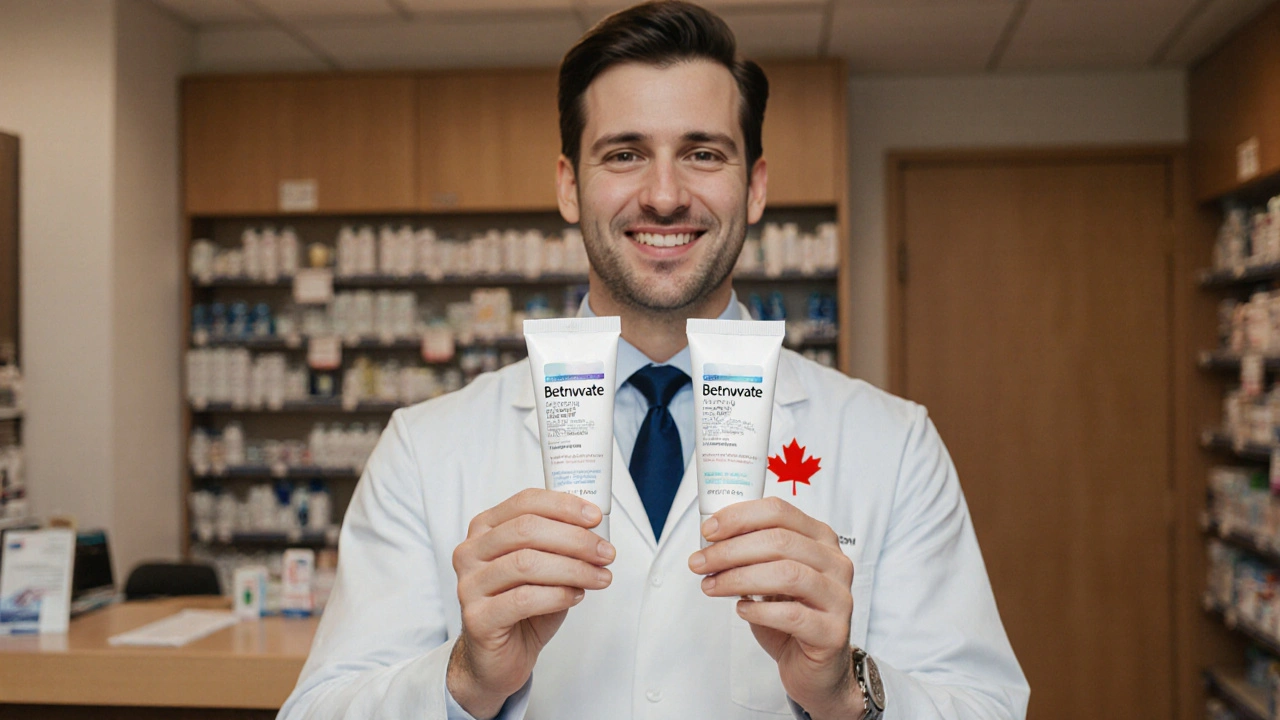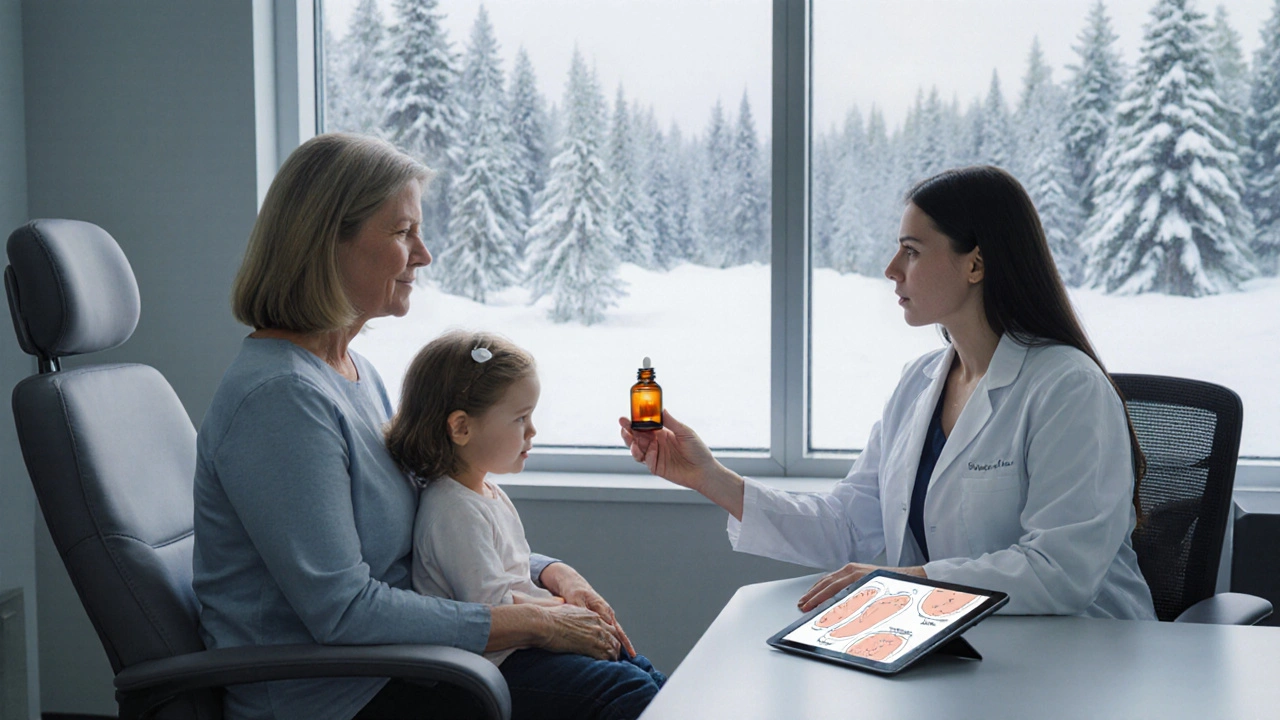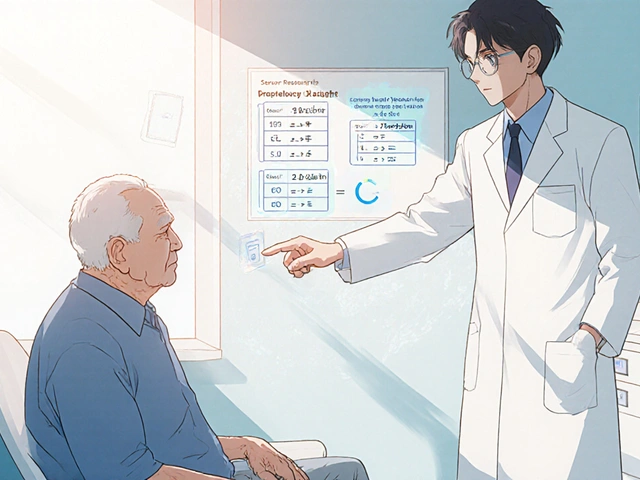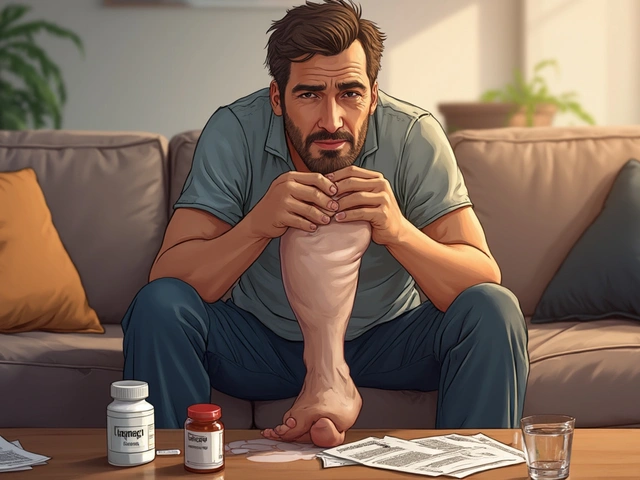
Topical Steroid Selector
This tool helps you select the appropriate topical steroid cream based on your condition's severity, affected area, age group, and expected treatment duration.
Betnovate is a household name for a potent steroid cream, but how does it really stack up against other options? Below you’ll find a quick snapshot, followed by a deep dive that lets you pick the right product for eczema, psoriasis or any inflamed skin.
TL;DR
- Betnovate (betamethasone 0.1%) is a high‑potency corticosteroid, prescription‑only in the UK.
- Hydrocortisone is low‑potency, over‑the‑counter, good for mild irritation.
- Mometasone and desonide sit in the mid‑potency range, suitable for moderate flare‑ups.
- Clobetasol is ultra‑potent; reserve it for severe psoriasis or resistant eczema.
- Consider age, skin thickness, treatment length and cost before choosing.
What is Betnovate?
When treating inflammatory skin conditions, Betnovate is a brand‑name cream that contains betamethasone 0.1%, classified as a high‑potency topical corticosteroid. First launched in the 1970s, it quickly became a go‑to for doctors handling stubborn eczema, dermatitis and psoriasis. In the United Kingdom it is prescription‑only, reflecting its strength and the need for medical oversight.
How Betamethasone Works
Betamethasone is a synthetic glucocorticoid that binds to intracellular receptors, reducing the release of inflammatory mediators such as prostaglandins and cytokines. This dampens redness, swelling and itching within hours. Because it penetrates the epidermis efficiently, it can reach deeper dermal layers, making it effective for thick‑skinned areas like elbows and knees.

Common Alternatives
Not every rash needs a high‑potency steroid. Below are the most frequently prescribed alternatives, each with its own potency tier, prescription status and typical use case.
Clobetasol Propionate
Clobetasol is an ultra‑potent (class I) corticosteroid, usually at 0.05% concentration, reserved for severe psoriasis or resistant eczema. It requires a short‑term course (max 2 weeks) to avoid skin atrophy.
Hydrocortisone
Hydrocortisone is a low‑potency (class VII) steroid available over the counter at 0.5% or 1% strengths, ideal for mild dermatitis, insect bites and diaper rash. It has a very favorable safety profile for long‑term use on sensitive skin.
Mometasone Furoate
Mometasone falls into the mid‑potency (class III-IV) range, commonly at 0.1% concentration, and is often prescribed for moderate eczema or lichen planus. It balances efficacy with a lower risk of thinning compared to betamethasone.
Desonide
Desonide is a low‑to‑mid potency (class VI-V) cream, typically 0.05%, used for facial or intertriginous areas where higher‑potency steroids would be too harsh. Its gentle profile makes it popular for pediatric use.
Triamcinolone Acetonide
Triamcinolone is a medium‑potency (class IV) steroid at 0.025%-0.1% concentrations, often chosen for widespread eczema or allergic contact dermatitis. It offers a middle ground between hydrocortisone and betamethasone.
Side‑by‑Side Comparison
| Drug | Potency (UK class) | Typical Concentration | Prescription? | Best For |
|---|---|---|---|---|
| Betnovate (Betamethasone) | Class II‑III (high) | 0.1% | Yes | Moderate‑severe eczema, psoriasis, thick‑skin areas |
| Clobetasol Propionate | Class I (ultra‑high) | 0.05% | Yes | Severe psoriasis, resistant dermatitis |
| Hydrocortisone | Class VII (low) | 0.5%‑1% | No (OTC) | Mild irritations, insect bites, diaper rash |
| Mometasone Furoate | Class III‑IV (mid‑high) | 0.1% | Yes | Moderate eczema, lichen planus |
| Desonide | Class VI‑V (low‑mid) | 0.05% | Yes (often pediatric) | Facial, intertriginous, pediatric dermatitis |
| Triamcinolone Acetonide | Class IV (mid) | 0.025%‑0.1% | Yes | Widespread eczema, allergic contact dermatitis |
Choosing the Right Cream for You
Here’s a quick decision tree you can run through in the bathroom mirror:
- How severe is the flare‑up? Mild (redness, slight itching) → start with hydrocortisone. Moderate to severe → consider betamethasone or mometasone.
- Where is the rash? Thin skin (face, folds) → pick a low‑potency or gentle mid‑potency option like desonide or mometasone. Thick skin (knees, elbows) → high‑potency such as betamethasone works better.
- Age of the patient? Children under 12 usually need the gentlest steroid-hydrocortisone or desonide. Adults can handle higher potencies, but only under medical guidance.
- Duration of use? If you need more than two weeks, avoid ultra‑potent agents (clobetasol) and opt for mid‑potency creams to limit skin thinning.
- Cost and access? Over‑the‑counter hydrocortisone is cheap and fast. Prescription steroids may be covered by NHS, but you’ll need a GP appointment.
Following this flow will keep you from over‑treating a simple rash or under‑treating a stubborn plaque.
Safety Tips & Common Side Effects
Topical steroids sound scary, but when used correctly they’re safe. Typical side effects include mild burning, dryness or a temporary increase in redness. Prolonged high‑potency use can cause skin atrophy, stretch marks, or suppression of the body’s own cortisol production.
Key safety practices:
- Apply a thin layer-more isn’t better.
- Limit use to the prescribed area; avoid occlusion unless directed.
- Do not use on active fungal infections without treating the fungus first.
- Take breaks (e.g., two days off per week) for long‑term regimens.
- Consult a pharmacist or GP if you notice worsening skin, thinning, or systemic symptoms.

Frequently Asked Questions
Is Betnovate safe for long‑term use?
Can I use Betnovate on my face?
Betnovate is high‑potency, so it’s generally avoided on thin facial skin unless a doctor specifically prescribes it for a short period. For facial eczema, many clinicians start with desonide or low‑potency hydrocortisone.
How quickly will I see improvement?
Most patients notice reduced redness and itching within 24‑48hours. Full clearing of thick plaques may take 1‑2weeks of consistent use.
Can I combine Betnovate with moisturizers?
Absolutely-apply the steroid first, let it absorb for a few minutes, then seal in moisture with an emollient. This helps reduce dryness and supports skin healing.
What are the risks of using clobetasol instead?
Clobetasol is ultra‑potent; misuse can cause rapid skin thinning, steroid‑induced acne, and systemic absorption leading to adrenal suppression. It should be limited to short bursts under medical supervision.
Is there a generic version of Betnovate?
Yes-generic betamethasone valerate creams are available, often at a lower cost. They contain the same active ingredient and potency, but branding and excipients may differ.
Armed with this comparison, you can talk to your GP or pharmacist with confidence, knowing which steroid fits your skin’s needs without over‑ or under‑doing it.
Write a comment
Your email address will not be published.






16 Comments
The guide is thorough, but it suffers from a few avoidable slip-ups: the HTML entities for “<” and “>” aren’t escaped consistently, the term “high‑potency” toggles between hyphenated and non‑hyphenated forms, and the table header for “Typical Concentration” lacks a closing tag, which can break the layout on some browsers. Also, the bullet points under TL;DR switch between singular and plural without a clear pattern. Finally, the “Frequently Asked Questions” section repeats the question “Can I use Betnovate on my face?” twice, which feels redundant. Tightening these details would make the guide look as professional as its content suggests.
Thanks for pulling all this info together it really helps anyone trying to figure out which steroid to use for their skin type especially when you’re juggling age and severity we appreciate the inclusive approach
Honestly this guide feels like it was written by someone who never set foot in a proper British pharmacy, 🙄🇬🇧! The UK requires a prescription for betamethasone for a reason – it isn’t a “just‑pick‑anything” product, and the guide glosses over that with way too much hype!!! If you’re not careful you’ll end up with a worse rash than you started with, so read the fine print, read the warning labels, and stop treating steroids like candy!!! 😤
Oh great another “selector” tool – because what we really need is an algorithm to tell us whether to slather on a corticosteroid or a moisturizer. The flowchart assumes you’ve already consulted a dermatologist, which, surprise, you haven’t. Mid‑potency, high‑potency, class I, class VII – the jargon is enough to make a pharmacologist’s head spin. If you want a real decision, just check the potency chart and trust your doctor, not a button on a website.
Reading this guide raises a red flag about the pharmaceutical industry’s influence – the way Betnovate is highlighted as the “high‑potency” option feels like a subtle push from the manufacturers, especially when the same brand is repeatedly promoted without mentioning cheaper generic alternatives. It’s worth remembering that many of these “prescription‑only” labels are used to control the market rather than protect patients. Keep an eye on who profits from the recommendations.
I love how the guide breaks down the potencies – it makes choosing a steroid feel less intimidating 🙂. The side‑effect section is especially helpful for folks who worry about long‑term skin thinning.
Betnovate is often the first name that comes to mind when someone mentions a strong steroid cream, but understanding why you might pick it over other options is essential. First, betamethasone 0.1% is classified as a high‑potency steroid, which means it works faster on thick, stubborn plaques. Second, its prescription‑only status in the UK forces a doctor’s oversight, reducing the chance of misuse. Third, the drug penetrates deeper layers of the skin, making it suitable for elbows and knees where eczema can be thick. Fourth, the side‑effect profile includes potential skin thinning if used too long, so a clear treatment plan is critical. Fifth, for facial or intertriginous areas, a lower‑potency steroid like desonide is usually safer, which the guide mentions. Sixth, the guide correctly points out that over‑the‑counter hydrocortisone is ideal for mild irritation and can be used daily. Seventh, mid‑potency options such as mometasone strike a balance between efficacy and safety for moderate flares. Eighth, clobetasol should be a last‑resort drug because its ultra‑potent nature can cause rapid atrophy. Ninth, the cost factor matters – generic betamethasone can be cheaper than the brand name, which may affect access. Tenth, the interactive selector is a nice touch, but it cannot replace a professional assessment. Eleventh, many patients forget to apply a moisturizer after the steroid, which can worsen dryness. Twelfth, the guide’s safety tips about thin layers and breaks in treatment are spot‑on. Thirteenth, a common mistake is occluding the area without medical advice, which can increase absorption dramatically. Fourteenth, always watch for signs of systemic absorption such as mood changes or weight gain. Finally, having this comparison in one place empowers patients to ask the right questions at the doctor’s office and avoid both under‑ and overtreatment.
Great summary, Laneeka! If you’re ever unsure, start with the lowest potency that still helps and work up as needed – the skin will thank you.
Nice breakdown.
Ah, the theater of dermatology! One moment you’re a humble skin sufferer, the next you’re thrust onto the stage of high‑potency potions, each cream a dramatic actor delivering its monologue of relief or ruin. The guide, dear reader, is your script, but remember: the spotlight can blind as easily as it illuminates.
Esteemed colleagues, it is with a profound sense of scholarly duty that I engage this treatise on topical corticosteroids, for the gravitas of cutaneous pharmacotherapy demands no less than meticulous scrutiny. The author has commendably assembled a compendium of agents ranging from the humble hydrocortisone, a veritable workhorse of the low‑potency class, to the formidable clobetasol, whose ultra‑potent lineage is reserved for the most recalcitrant of dermatoses. Yet, amidst this laudable effort, one discerns a subtle bias towards Betnovate, whose high‑potency classification may inadvertently eclipse the merits of its peers. It is imperative, therefore, to underscore that the therapeutic hierarchy must be dictated by the nuanced interplay of lesion morphology, patient age, and comorbidities, rather than mere brand recognition. Moreover, the inclusion of a decision‑making algorithm, while pedagogically appealing, must be tempered with the admonition that no digital contrivance may supplant the sagacity of a seasoned clinician. In summation, the guide stands as an invaluable resource, provided its readership approaches it with both reverence for evidence and vigilance against over‑reliance upon its prescriptive sheen.
I appreciate the balanced tone – it’s clear the author isn’t pushing any one product, just laying out the facts. The reminder to pair steroids with moisturizers is something I wish more guides emphasized.
Looks solid – just remember, if you’re ever in doubt, a quick chat with your pharmacist can save you a lot of hassle down the road.
While the guide pretends to be an impartial comparison, it subtly glorifies Betnovate with flowery language that borders on evangelism, leaving the reader with a lingering suspicion that commercial interests may have seeped into the narrative.
This is a helpful guide thanks for sharing it
Cool info